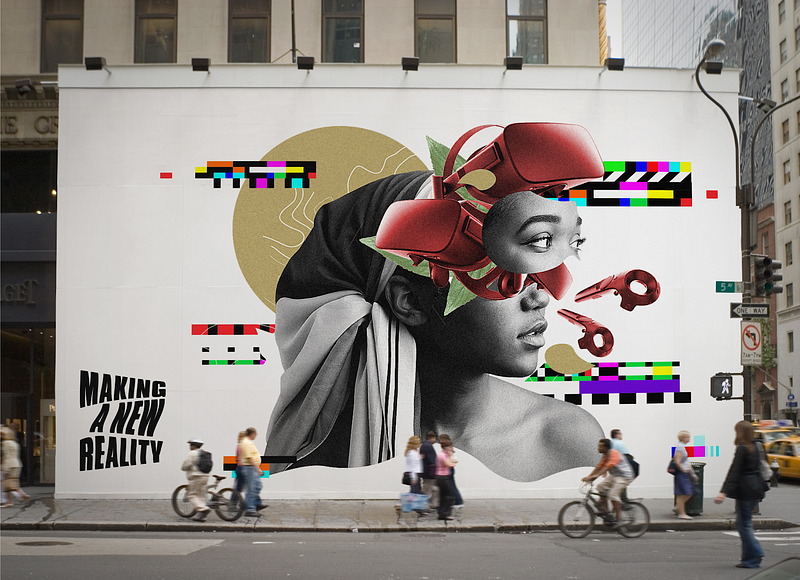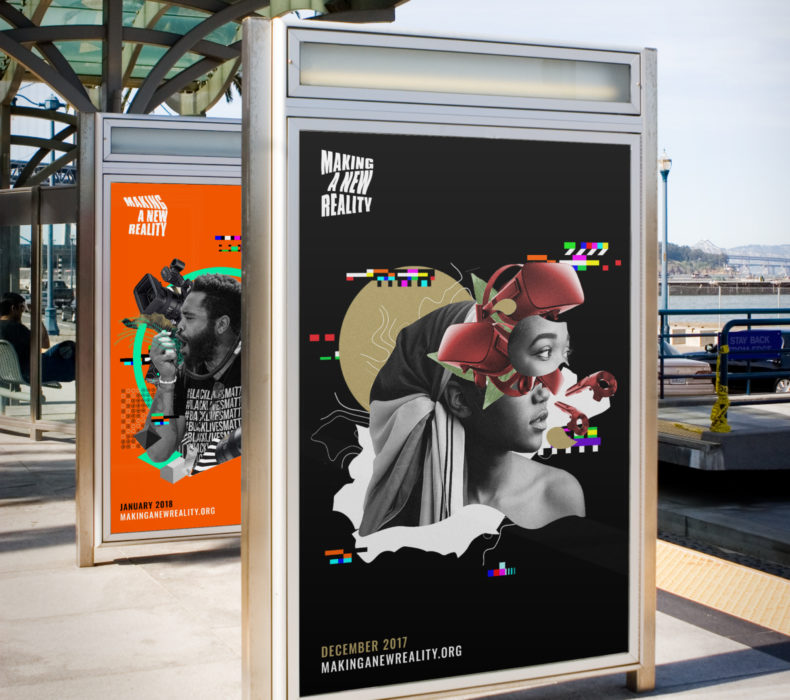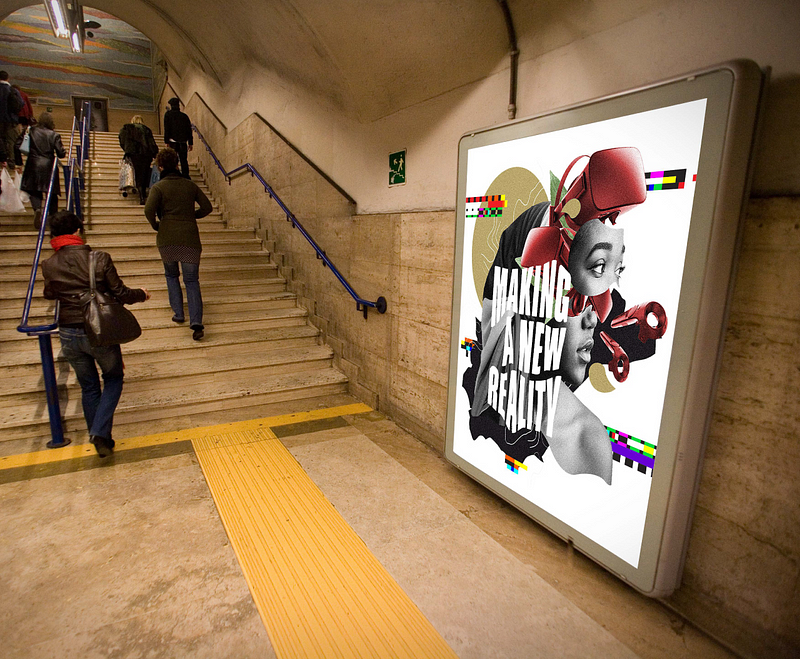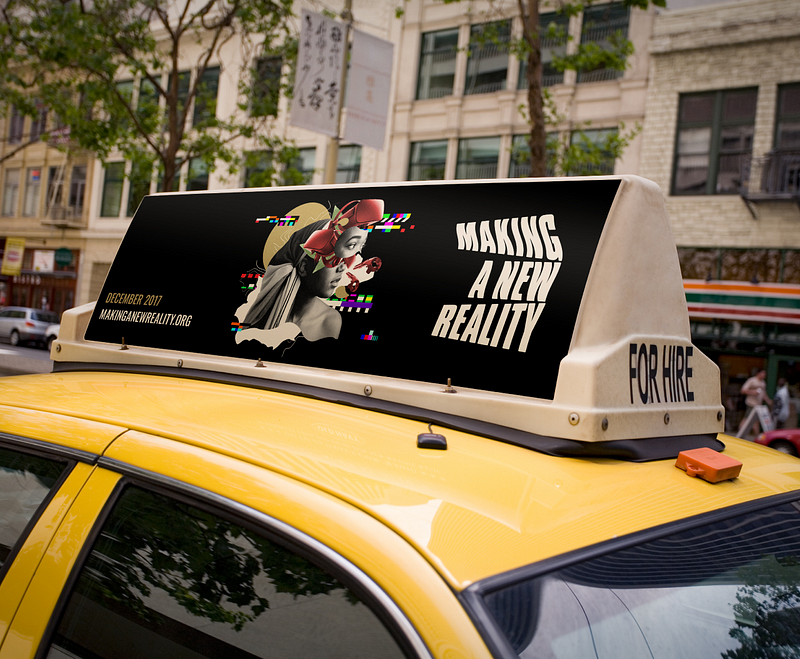We know what to do, but do we have the will? – Darren Walker, President of the Ford Foundation, Refiguring the Future, 2018
By Kamal Sinclair
For almost two years, on a daily basis, I’ve been asking myself and everyone in my radius: “How do we make a new reality that centers the values of equality, equity, and inclusion through emerging media?”
The answers were dizzying and often felt beyond the reach of possibility, so there were moments I almost lost faith in the work. You can imagine my joy when the affirmations began to flow, first in a trickle and now in powerful waves, making it clear that this work is urgent, meaningful, and achievable.
 Here’s one of several images from
a proposed campaign for Making a New Reality by In-House
International that are inspiring us to think about what comes next for this work.
Here’s one of several images from
a proposed campaign for Making a New Reality by In-House
International that are inspiring us to think about what comes next for this work.
From the Deviant Artists…
At the Ford Foundation JustFilms Emerging Media Summit this summer I had the opportunity to spend time with the deviant artists in the tech space. They are already on the frontlines of the civil rights movements of the future and are challenging us to ask:
- Why are we frantically innovating into the future we are currently on track to create?
- Who do we really want to be in that future?
- How will we establish value systems, ethics, and well-being in that future?
These artists are from a broad range of identity backgrounds, working at the intersection of art and bioengineering, artificial intelligence, public media, immersive media, brain hacking, data storytelling, social art practices, speculative objects, and futurist narratives. Seeing them gathered in one space, laughing, questioning, sharing, educating us and each other, developing community, and unapologetically putting stakes in the ground for justice, well-being, and prosperity was a deep and powerful affirmation.
Of course, these artists represent a small fraction of artists starting to awaken, assemble, and collaborate on the future of culture.
 Image from a proposed campaign for
Making a New Reality by In-House
International.
Image from a proposed campaign for
Making a New Reality by In-House
International.From the Deviant Geeks…
This summer I made a trip to Silicon Valley. The first day I had a series of meetings at Stanford University that went from disheartening to transcendent. My early meetings exposed the thickness of the famed “Silicon Valley bubble,” when I realized that powerful and influential people on the campus had little reference for some of the most landmark works in emerging media storytelling and that their industry analysis (which informs some of the most powerful tech firms and investor cohorts in the industry) is faulty and skewed. I left the meeting feeling like there was no hope for working within Silicon Valley to make change and that maybe our only hope was to “Buckminster Fuller” emerging media and build new systems from the ground up.
However, each meeting got successively more enlightened and engendered more hope, until my final meeting of the day with a mechanical engineer at the design school who exposed me to what he called “the deviant geeks” of Silicon Valley. He showed me that there is a passionate community of technologists and engineers who not only want to design for justice and well-being, but beauty. A powerful affirmation!
The following day I went to Facebook headquarters in Menlo Park to present for the Oculus Women series with Yelena Rachitsky, at the invitation of Ebony Peay-Ramirez. Although I have great relationships with these women at Facebook, I was nervous to present Making a New Reality in this environment because of the critiques that emerged in the research of “the Valley” mythologies, the company, and its founder. I was steadied by the comments from a good number of interviewees who said it is critical for those working on equality to “be in the room” of these centers of power, despite suspicions, because it is a more powerful position to be “in the room” than “outside throwing rocks.”
To my joy, the community I engaged at Facebook was ready and eager to have this frank conversation, to take ownership, and to work towards mitigating future blind spots. The event was maybe a third full, with a live video being streamed to staff at their desks. Throughout the talk and conversation people started coming down from their desks and coming into the room. The conversation was so robust we went almost an hour over the original end time. Afterwards I had person after person passionately asking how they could disrupt the blind spots in Silicon Valley and further design principles grounded in justice, well-being, and prosperity. Again, I was exposed to the deviant geeks and they were awesome!!! Another wave of affirmation.
Of course, these “geeks” represent a small fraction of people beginning to awaken, assemble, and collaborate on the future of culture. The momentum building in the #TechWontBuildIt, #MoreThanCode, #PublicInterestTech, and #HumaneTech movements are a testament to that fact.
 Image from a proposed campaign for
Making a New Reality by In-House
International.
Image from a proposed campaign for
Making a New Reality by In-House
International.From the Privileged…
This month I attended a very prestigious event for producers of film and TV, where I had the opportunity to present on the Making a New Reality research. Affirmations came when person after person from centers of power like Amazon, Netflix, film studios, and financiers came up to me wanting to galvanize their resources to heed the call to action.
One affirmation came to me while sitting in a dark screening room with 200 industry decision makers, when one white man made a vulnerable admission of his complicity in the suppression of black people in film. As we talked about the successes of Black Panther and Moonlight, he shared that for 12 years he followed his mentors’ advice not to make black films if he wanted to make money, a choice he deeply regrets.
For 20+ years I too heard the narrative that black people just needed more education, more skills, more artistry, or more willingness to play into the minstrel stereotypes in order to succeed. Just like him, I heard statements like: “Black films just don’t sell.” “This is a business first, so we have to make what sells.” “No one will believe that character, you need to make them more street.” Do you know how crazy that can make you feel? When you know the truth of your worth and when you doubt it?
To hear him validate that there was an explicit narrative, an industry mythology, that he bought into and helped perpetuate was an affirmation — at least that I’m not crazy. Then to hear him apologize was an affirmation that rigid bias can change. Truth and reconciliation is a powerful thing; even this small step towards it made a part of my heart soften. This small willingness to tell the truth caused something resembling healing in me.
He was not the only one to break with narratives that perpetuate inequality, to demonstrate allyship, and to offer a commitment to change. It has been an increasing part of the conversation around this research. In fact, this part of the discourse has exposed another dominant narrative among those in positions of privilege that maintain the status quo, particularly related to white privilege.
At one of the events where I presented the research, a white woman said, “I’m so excited for this initiative and 100% committed to diversity and inclusion, but how are we going to get white people to give up what they have, so others can have a seat at the table?”
I was genuinely taken aback by her question, because I really never thought of it as a zero-sum proposition, where someone has to lose for others to gain. In fact, I never thought of “white people” having to give up anything, because I’ve always seen them as already operating in a deep deficit. The circumstances of history have caused massive numbers of non-white people to live under restrictive systems that hindered the development of their potential.
There is empirical study after empirical study that shows the negative impact on all of us, when groups of people are not able to fulfill their potential. We lose their brilliance in whatever field of study or area of practice they would have advanced. We lose whatever contributions they may have made to science, medicine, technology, philosophy, art, culture, or commerce. Perhaps they had the potential to find a cure for the very ailment that will eventually kill you. We also gain the burden of human potential suppressed (i.e. expensive prison systems, abusive immigration systems, the impacts of poverty in our cities, climate change, war, and mental health epidemics).
Those whose privilege is generated by the oppression of others over long periods of time suffer from this “privilege.” They suffer the loss of contributions oppressed peoples could have made to their well-being, as we discussed in the first article when unpacking Heather Rae’s quote about climate change and its direct correlation to the oppression of indigenous peoples contributions to designing our value systems in the industrial age. They also suffer from the mental health impacts of generations of their kin living in the constant fear and paranoia of rebellion, the guilt of benefiting from another’s pain, the consequences of victim-perpetrator dynamics, and/or the dissociation with reality caused by the dehumanization of another to preserve a moral self-identity.
The fears embedded in the “zero-sum” framing in the context of furthering diversity, equality, equity, and inclusion is probably a key factor in our failure to achieve these goals in media and in society. Especially, when notions of scarcity helped fuel systems of oppression historically and systems of oppression help fuel fear or paranoia of the other, or of the oppressed. The fears embedded in notions of scarcity also fuel our frenzied appetite for exponential growth, expansion, and productivity, which can hinder the adoption of the values of reflection, collaboration, and consultation.
As Morgan Willis, Director of the Allied Media Conference, told me during my interviews for this research project:
The person that needs to be most changed in this scenario is ‘this guy’ who is making the decisions because he’s the one in power to ultimately put people in these positions… There’s such inequity and inequality that it is ‘his’ responsibility to both receive the diverse people coming to him AND to do the work of recruiting people from underrepresented groups… Ultimately, that handful of [privileged] people are going to have to accept their responsibility to diversify their rooms if it is ever going to change.
How do we structure involvement at that level in a way that resources him with a framework, a blueprint and the tools, language, and a way of holding him accountable to doing something that he’s probably never had to do? We have to consider that throughout his entire life, he’s never had to think about who to put in a room. That does not mean that he’s not able to be transformed.
If he does this, his room will give back. You’re diversifying not just the representation of people, but ideas, creativity, imagination and perspective. You can’t really get that when you have a room full of yourself.
Scarcity is an antiquated concept, but our economic systems are still operating on the fear of it and therefore perpetuating a constant and exponential hunger for growth, especially for those that have already accumulated more than they could ever use. We are in an age of abundance, but we are still operating on the subconscious survival mechanisms of scarcity.
Artificial Intelligence alone is a “surplus technology” that can help us manage the earth’s resources in a sustainable and balanced way (even if it will never be the same as it was as it was before human-induced climate change) if we have the will to re-organize according to this new reality. We have enough to feed, house, and provide medical care for the earth population right now if we can create the political will.
And if we care for more than just people’s bodies and elevate their intellectual and creative potential, we will attain a level of civilization that we’ve never seen. We can enact an enlightenment and become a more true civilization, not one that claims allegiance to civility but fails in practice. We have the opportunity to become a better version of ourselves.
 Image from a proposed campaign
for Making a New Reality by In-House
International.
Image from a proposed campaign
for Making a New Reality by In-House
International.What comes next?
There has been a wonderful response from philanthropists, academic institutions, industry related companies and community organizations. In fact, we are already exploring strategies with institutions such as Johns Hopkins University, MIT and Stanford University to apply the recommendations from the research in intersectional programs and pedagogy. We are also developing initiatives to share the research in communities that are ripe for taking leadership positions in furthering equality in emerging media. Finally, we are planning further opportunities to convene as a field to outline strategies for structural change to enable the artists, technologists, policymakers, community leaders and scientists to make a new reality.
At Immerse, we’ll continue to both amplify the findings and insights from the Making a New Reality research, and to find new writers and respondents to explore these themes. To do this, I’ll be stepping into a new role, as a contributing editor for the publication: send me your story ideas at newreality@immerse.news.
We’ll also need your help to spread the word. Below, you’ll find a summary of the research that you can share with colleagues, students, inventors, investors, and anyone else who has a stake in this issue. Please tag us on Twitter using the #makinganewreality hashtag; we are excited to see how the conversation evolves.
On the Making a New Reality site this month, you’ll also find notes from the Ford Foundation JustFilm’s Emerging Media Summit, a summary of the research, and a framework for action. Stay tuned for more in the coming months.
- Making a New Reality Summary
- Notes from the JustFilms Emerging Media Summit
- What is a Framework for Action? Discussed in the Democratize Design article.
The Making a New Reality research project is authored by Kamal Sinclair with support from the Ford Foundation JustFilms program and supplemental support from the Sundance Institute. Learn more about the goals and methods of this research, who produced it, and the interviewees whose insights inform the analysis.
Immerse is an initiative of MIT Open DocLab and The Fledgling Fund, and is fiscally sponsored by IFP. Learn more about our vision for the project here.